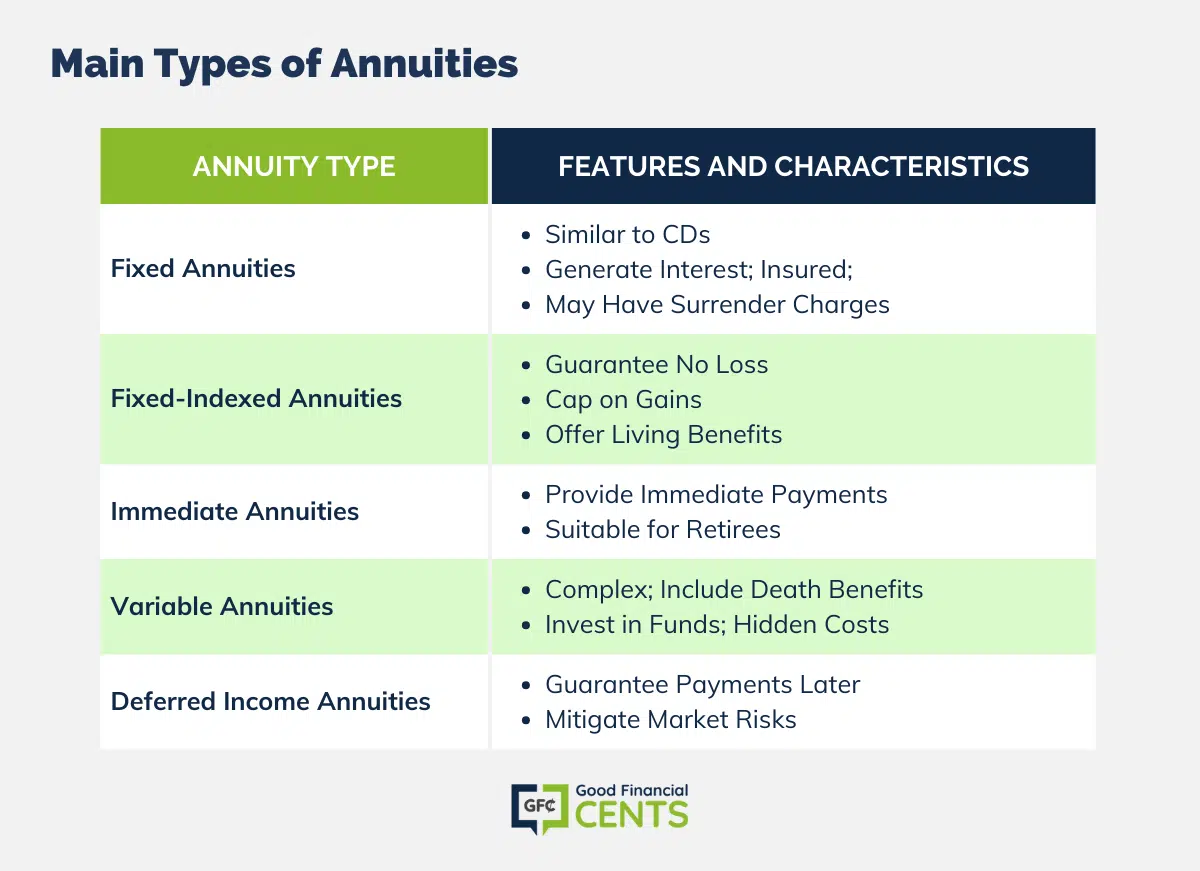Featured
Table of Contents
The settlement may be spent for development for an extended period of timea solitary premium delayed annuityor invested for a short time, after which payout beginsa solitary premium prompt annuity. Solitary premium annuities are frequently funded by rollovers or from the sale of a valued possession. An adaptable premium annuity is an annuity that is intended to be moneyed by a collection of payments.
Owners of taken care of annuities know at the time of their purchase what the worth of the future cash flows will be that are produced by the annuity. Undoubtedly, the number of capital can not be known ahead of time (as this relies on the contract owner's life-span), yet the assured, dealt with rate of interest at the very least provides the proprietor some level of assurance of future earnings from the annuity.
While this distinction seems basic and simple, it can dramatically influence the worth that a contract owner ultimately originates from his or her annuity, and it creates significant unpredictability for the agreement proprietor - Variable annuity subaccounts. It likewise generally has a product effect on the level of charges that a contract owner pays to the providing insurance provider
Set annuities are often used by older investors that have actually limited properties but that wish to offset the risk of outlasting their properties. Set annuities can serve as an efficient device for this purpose, though not without particular drawbacks. In the situation of instant annuities, once an agreement has actually been purchased, the agreement owner gives up any and all control over the annuity assets.
Understanding Financial Strategies A Closer Look at Fixed Annuity Vs Equity-linked Variable Annuity Defining Variable Vs Fixed Annuities Features of Smart Investment Choices Why Choosing the Right Financial Strategy Matters for Retirement Planning Variable Vs Fixed Annuity: Explained in Detail Key Differences Between Fixed Income Annuity Vs Variable Annuity Understanding the Risks of Long-Term Investments Who Should Consider Fixed Interest Annuity Vs Variable Investment Annuity? Tips for Choosing Fixed Annuity Or Variable Annuity FAQs About Annuity Fixed Vs Variable Common Mistakes to Avoid When Planning Your Retirement Financial Planning Simplified: Understanding Fixed Income Annuity Vs Variable Annuity A Beginner’s Guide to Smart Investment Decisions A Closer Look at How to Build a Retirement Plan
An agreement with a normal 10-year surrender period would certainly bill a 10% surrender fee if the contract was surrendered in the first year, a 9% abandonment cost in the second year, and so on up until the surrender charge reaches 0% in the contract's 11th year. Some postponed annuity contracts include language that permits tiny withdrawals to be made at numerous intervals throughout the abandonment duration scot-free, though these allowances typically come at an expense in the form of lower surefire rate of interest.
Simply as with a repaired annuity, the proprietor of a variable annuity pays an insurer a lump amount or series of payments in exchange for the promise of a collection of future settlements in return. But as discussed over, while a fixed annuity grows at an assured, constant price, a variable annuity expands at a variable rate that depends upon the performance of the underlying financial investments, called sub-accounts.
During the accumulation phase, properties bought variable annuity sub-accounts grow on a tax-deferred basis and are taxed just when the contract owner takes out those incomes from the account. After the build-up phase comes the income phase. With time, variable annuity possessions should theoretically enhance in worth until the agreement proprietor chooses she or he wish to begin withdrawing money from the account.
The most significant concern that variable annuities typically present is high cost. Variable annuities have a number of layers of charges and costs that can, in accumulation, create a drag of up to 3-4% of the contract's value yearly. Below are the most usual costs related to variable annuities. This cost makes up the insurance firm for the danger that it thinks under the regards to the contract.
M&E expenditure fees are calculated as a percent of the contract value Annuity companies pass on recordkeeping and other administrative prices to the contract owner. This can be in the form of a level annual charge or a portion of the contract worth. Administrative charges might be included as part of the M&E danger fee or might be analyzed separately.
These fees can range from 0.1% for easy funds to 1.5% or more for actively handled funds. Annuity agreements can be customized in a variety of ways to offer the specific needs of the agreement owner. Some typical variable annuity riders include assured minimal accumulation advantage (GMAB), assured minimum withdrawal advantage (GMWB), and guaranteed minimum income benefit (GMIB).
Understanding Fixed Index Annuity Vs Variable Annuities Key Insights on Annuities Fixed Vs Variable Defining Fixed Vs Variable Annuities Advantages and Disadvantages of Different Retirement Plans Why Retirement Income Fixed Vs Variable Annuity Matters for Retirement Planning Fixed Annuity Vs Variable Annuity: How It Works Key Differences Between Variable Vs Fixed Annuities Understanding the Rewards of Long-Term Investments Who Should Consider Fixed Annuity Vs Variable Annuity? Tips for Choosing Fixed Vs Variable Annuity FAQs About Fixed Annuity Or Variable Annuity Common Mistakes to Avoid When Planning Your Retirement Financial Planning Simplified: Understanding Your Options A Beginner’s Guide to Smart Investment Decisions A Closer Look at How to Build a Retirement Plan
Variable annuity contributions give no such tax reduction. Variable annuities have a tendency to be very inefficient vehicles for passing wealth to the following generation because they do not delight in a cost-basis change when the initial contract owner dies. When the proprietor of a taxable investment account passes away, the cost bases of the investments held in the account are gotten used to reflect the marketplace rates of those investments at the time of the proprietor's fatality.
Beneficiaries can acquire a taxable financial investment profile with a "tidy slate" from a tax obligation point of view. Such is not the instance with variable annuities. Investments held within a variable annuity do not receive a cost-basis modification when the initial owner of the annuity passes away. This suggests that any type of accumulated unrealized gains will certainly be handed down to the annuity owner's heirs, in addition to the connected tax obligation concern.

One substantial concern connected to variable annuities is the possibility for problems of rate of interest that might feed on the part of annuity salesmen. Unlike a monetary expert, who has a fiduciary duty to make financial investment decisions that profit the client, an insurance policy broker has no such fiduciary responsibility. Annuity sales are extremely profitable for the insurance coverage professionals that market them as a result of high in advance sales compensations.
Several variable annuity contracts have language which positions a cap on the percent of gain that can be experienced by specific sub-accounts. These caps prevent the annuity owner from completely taking part in a section of gains that could otherwise be enjoyed in years in which markets produce considerable returns. From an outsider's viewpoint, it would certainly seem that capitalists are trading a cap on investment returns for the aforementioned ensured floor on financial investment returns.
Decoding Pros And Cons Of Fixed Annuity And Variable Annuity A Comprehensive Guide to Investment Choices What Is Choosing Between Fixed Annuity And Variable Annuity? Advantages and Disadvantages of Deferred Annuity Vs Variable Annuity Why Choosing the Right Financial Strategy Is Worth Considering Indexed Annuity Vs Fixed Annuity: Explained in Detail Key Differences Between Different Financial Strategies Understanding the Risks of Long-Term Investments Who Should Consider Strategic Financial Planning? Tips for Choosing Fixed Income Annuity Vs Variable Annuity FAQs About Fixed Annuity Vs Equity-linked Variable Annuity Common Mistakes to Avoid When Choosing Annuities Fixed Vs Variable Financial Planning Simplified: Understanding Your Options A Beginner’s Guide to Smart Investment Decisions A Closer Look at How to Build a Retirement Plan
As noted over, give up fees can badly restrict an annuity owner's capacity to move properties out of an annuity in the early years of the contract. Additionally, while a lot of variable annuities allow contract proprietors to withdraw a defined quantity throughout the build-up phase, withdrawals beyond this amount typically cause a company-imposed charge.
Withdrawals made from a set rates of interest investment option could likewise experience a "market value adjustment" or MVA. An MVA adjusts the worth of the withdrawal to mirror any adjustments in rates of interest from the time that the cash was purchased the fixed-rate choice to the time that it was withdrawn.

Frequently, even the salespeople that market them do not totally understand just how they function, therefore salespeople in some cases take advantage of a buyer's emotions to market variable annuities as opposed to the values and viability of the items themselves. Our company believe that financiers should fully understand what they own and just how much they are paying to have it.
The same can not be stated for variable annuity possessions held in fixed-rate investments. These properties lawfully come from the insurer and would for that reason go to threat if the firm were to stop working. Likewise, any warranties that the insurance policy company has accepted offer, such as an ensured minimum revenue benefit, would certainly remain in question in case of a company failing.
Exploring the Basics of Retirement Options Key Insights on Annuity Fixed Vs Variable Defining the Right Financial Strategy Benefits of Fixed Annuity Or Variable Annuity Why Annuity Fixed Vs Variable Is a Smart Choice How to Compare Different Investment Plans: Simplified Key Differences Between Different Financial Strategies Understanding the Rewards of Long-Term Investments Who Should Consider Fixed Annuity Vs Equity-linked Variable Annuity? Tips for Choosing the Best Investment Strategy FAQs About Planning Your Financial Future Common Mistakes to Avoid When Choosing a Financial Strategy Financial Planning Simplified: Understanding Your Options A Beginner’s Guide to Smart Investment Decisions A Closer Look at Variable Vs Fixed Annuities
Potential buyers of variable annuities need to recognize and consider the monetary condition of the providing insurance coverage company before entering right into an annuity contract. While the benefits and disadvantages of numerous types of annuities can be discussed, the genuine problem bordering annuities is that of suitability.
As the saying goes: "Customer beware!" This post is prepared by Pekin Hardy Strauss, Inc. ("Pekin Hardy," dba Pekin Hardy Strauss Wealth Management) for informational functions only and is not planned as a deal or solicitation for service. The details and information in this article does not comprise legal, tax, accountancy, financial investment, or other professional advice.
Table of Contents
Latest Posts
Decoding Pros And Cons Of Fixed Annuity And Variable Annuity A Closer Look at Fixed Index Annuity Vs Variable Annuities Defining the Right Financial Strategy Benefits of What Is Variable Annuity Vs Fi
Analyzing Strategic Retirement Planning Everything You Need to Know About Fixed Annuity Vs Equity-linked Variable Annuity What Is Annuity Fixed Vs Variable? Benefits of Choosing the Right Financial Pl
Exploring the Basics of Retirement Options A Closer Look at Fixed Annuity Vs Equity-linked Variable Annuity Defining the Right Financial Strategy Pros and Cons of Fixed Vs Variable Annuity Pros Cons W
More
Latest Posts